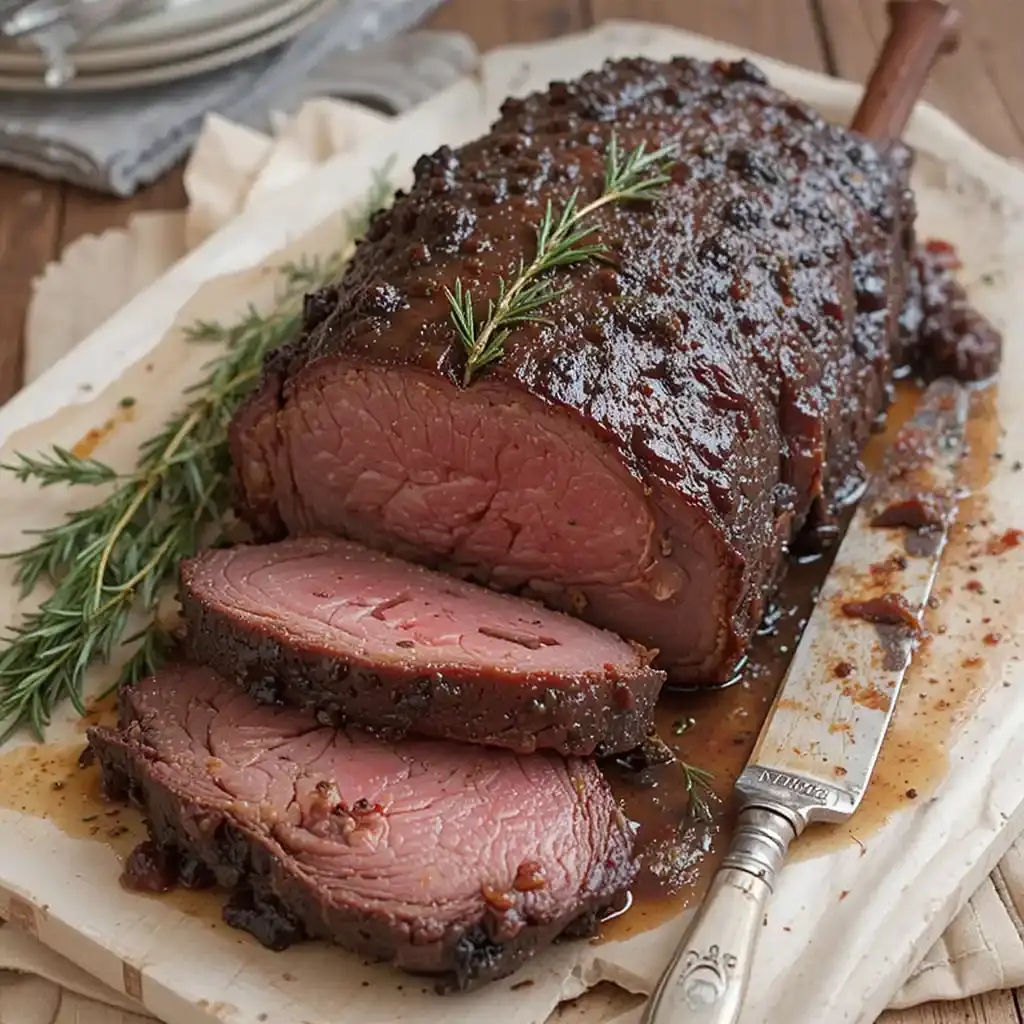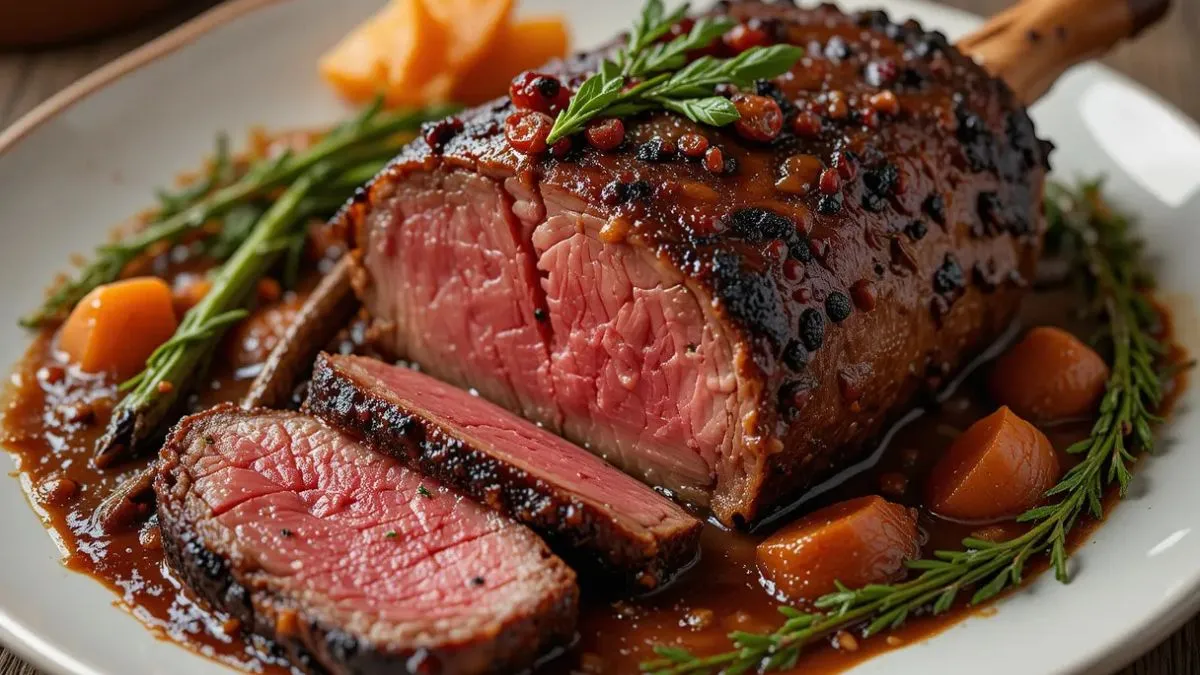Table of Contents
Venison Roast Recipe: Tender and Flavorful Wild Game Dish
Cooking a venison roast can be a challenge, even for seasoned chefs. Wild game meat needs special handling to turn tough cuts into tasty dishes. With the right techniques, your deer meat roast can become a true culinary gem.
A great wild game dish requires precision and knowledge. Hunters and cooking fans love venison for its rich taste and lean nutrition. By learning specific cooking methods, you can make a tender, juicy venison roast that wows everyone.
Key Takeaways
- Venison requires specialized cooking techniques
- Wild game meat offers unique nutritional benefits
- Proper preparation prevents tough meat textures
- Temperature control is crucial for deer meat roast
- Marinades enhance venison’s natural flavors
- Patience during cooking yields best results
Understanding Venison: A Premium Wild Game Meat
Venison is a special and healthy meat choice for hunters and food lovers. It has a unique taste and is very nutritious.
Nutritional Benefits of Deer Meat
Venison is full of health benefits. It’s packed with nutrients that are good for you. Deer meat has:
- High protein content with low fat levels
- Rich source of iron and vitamin B12
- Excellent zinc and selenium minerals
- Lower cholesterol compared to beef
Different Cuts of Venison
Knowing about deer meat cuts helps you pick the best roast. The top venison cuts are:
- Backstrap: Tender, premium cut along the spine
- Hindquarter: Lean, ideal for roasting
- Shoulder: Perfect for slow-cooking methods
- Tenderloin: Most delicate cut available
What Makes Venison Unique
Venison is special because of its wild origins. Its taste comes from the deer’s natural diet. The meat is lean, so it needs careful cooking to stay moist and tender.
Essential Equipment for the Perfect Deer Roast
Starting a delicious venison roast requires the right tools. Both professional hunters and home cooks agree. Quality deer roast tools can greatly improve your cooking.
For a perfect venison roast, you’ll need a few key items:
- Roasting pan with a rack
- Reliable meat thermometer
- Sharp boning knife
- Cutting board
- Heavy-duty aluminum foil
Specialized deer roast tools can take your wild game cooking to the next level. A good meat thermometer is essential. It helps ensure your venison is cooked just right without being overdone.
| Equipment | Purpose | Recommended Type |
| Roasting Pan | Even heat distribution | Stainless steel with non-stick rack |
| Meat Thermometer | Temperature monitoring | Digital instant-read |
| Knife | Trimming and cutting | 6-inch boning knife |
Pro tip: Choose venison roasting equipment that’s durable and easy to clean. Stainless steel and digital tools are often the best for cooking wild game.
When buying deer roast tools, prioritize quality over quantity. A few, versatile pieces are better than a lot of specialized gadgets.
Selecting and Preparing Your Venison Roast
Starting a delicious venison roast is more than just turning on the oven. Choosing the right cut and preparing the deer meat is key. This ensures a tender and flavorful meal.
Choosing the Right Cut
Not all venison cuts are the same for roasting. The best cuts come from specific areas of the deer:
- Hindquarters (top round or sirloin tip)
- Shoulder roasts
- Backstrap sections
Each cut has its own unique qualities. The hindquarter cuts are especially prized for their lean meat and minimal connective tissue.
Trimming and Cleaning
Proper deer meat preparation means careful trimming. Remove all visible silver skin and excess fat to avoid a gamey flavor. Use a sharp knife and work carefully to keep the meat intact.
| Cut Type | Recommended Trimming | Difficulty Level |
| Hindquarter | Remove silver skin | Moderate |
| Shoulder | Trim connective tissue | High |
| Backstrap | Minimal trimming needed | Easy |
Proper Thawing Methods
Thawing venison needs patience and careful handling. The safest method is refrigerator thawing. It prevents bacterial growth and keeps the meat quality high.
- Refrigerator thawing: 24-48 hours depending on roast size
- Cold water thawing: Sealed package in cold water, changing water every 30 minutes
- Avoid microwave thawing to prevent uneven heating
By following these guidelines, you’ll prepare a mouthwatering roast. It will showcase the unique qualities of wild game meat.
Best Marinades and Seasonings for Venison
Making the perfect venison marinade can change your deer meat from gamey to gourmet. Knowing the right deer meat seasonings is key to a delicious and tender roast. This will surely impress your dinner guests.
The secret to great venison is choosing marinades that match its rich, lean flavor. You want to boost the meat’s natural taste and cut down on any gamey notes.
- Red wine and herb marinades
- Citrus-based seasonings
- Garlic and rosemary blends
- Balsamic vinegar combinations
Here are some top venison marinade recipes to take your wild game cooking to the next level:
| Marinade Type | Key Ingredients | Marinating Time |
| Classic Red Wine | Red wine, garlic, thyme, black pepper | 4-6 hours |
| Citrus Herb | Orange juice, rosemary, olive oil | 2-4 hours |
| Balsamic Blend | Balsamic vinegar, mustard, brown sugar | 3-5 hours |
When making deer meat seasonings, remember that acid-based marinades soften tough meat. Ingredients like vinegar, wine, or citrus juice tenderize the meat and add depth of flavor.
Pro tip: Always marinate venison in the fridge and never at room temperature to avoid bacterial growth. Dry the meat before cooking for a perfect sear and to soak up more flavor.

Step-by-Step Venison Roast Recipe
Making a perfect venison roast recipe needs careful steps. Wild game meat needs special care to bring out its rich flavor. This guide will help you make a delicious meal that will wow any wild game lover.
Marinade Instructions
Marinating is key to tenderizing venison and boosting its flavor. Your venison roast recipes should have a strong marinade. It helps soften the meat and adds depth to its taste.
- Choose an acidic base like red wine or apple cider vinegar
- Add herbs such as rosemary, thyme, and sage
- Include olive oil for moisture
- Incorporate garlic and black pepper for additional flavor
Temperature Guidelines
It’s vital to control the temperature when cooking a tender deer roast. Cooking it too long can make it tough and dry.
| Doneness Level | Internal Temperature | Cooking Recommendation |
| Rare | 125°F | Remove at 120°F |
| Medium-Rare | 135°F | Remove at 130°F |
| Medium | 145°F | Remove at 140°F |
Cooking Times
Cooking time depends on the roast’s size and how you like it. A good rule for your venison roast recipe is to cook about 20-25 minutes per pound at 325°F.
Letting the meat rest for 10-15 minutes after cooking is important. It helps the juices spread evenly, making the deer roast moist and flavorful.
Cooking Methods and Techniques
Learning how to cook venison is all about mastering different roasting methods. These methods help keep the meat’s flavor and tenderness. Each method has its own benefits for making your wild game into a tasty meal.
Here are the main venison roasting methods:
- Oven Roasting: This is the classic way to cook deer meat roasts. Heat your oven to 325-350°F for even cooking.
- Slow Cooking: Great for tougher cuts, it makes the meat tender and flavorful.
- Sous Vide: A precise method that cooks the meat evenly in sealed bags at set temperatures.
Choose your cooking method based on the cut and what you want to achieve. Lean cuts need careful handling to avoid drying out. Fattier cuts can handle longer cooking times.
*Pro tip*: Always let your venison roast rest for 10-15 minutes after cooking. This helps the juices redistribute and makes the meat tender.
Each roasting method requires watching the temperature and timing closely. A meat thermometer is key to avoid overcooking and keep the venison tender.
| Cooking Method | Recommended Temperature | Cooking Time |
| Oven Roasting | 325-350°F | 20-25 minutes per pound |
| Slow Cooking | 200-250°F | 6-8 hours |
| Sous Vide | 131-140°F | 2-4 hours |
By learning these venison cooking techniques, you can turn wild game into a delicious, high-quality dish. It will impress anyone who tries it.
Tips for Achieving Tender, Juicy Results
Making a tender venison roast needs careful steps. Wild game meat needs special care to stay juicy and tasty. Both pros and home cooks know that making venison delicious involves a few key steps.
Moisture Control Techniques
Keeping moisture in is key for a tender venison roast. Deer meat can dry out fast without the right care. Here are some tips:
- Marinate the meat for at least 4-6 hours before cooking
- Use fat-based marinades to add moisture
- Cover the roast with bacon strips during cooking
- Baste frequently with beef or game stock
Strategic Resting Period
Letting your deer meat rest after cooking is vital. It helps juices spread evenly, making each slice juicy. Here’s what experts suggest:
- Let the roast rest for 10-15 minutes after cooking
- Tent the meat with aluminum foil during resting
- Keep the roast in a warm area
Precise Temperature Monitoring
Controlling temperature is crucial for your venison roast. Follow these tips for the best moisture and tenderness:
| Doneness Level | Internal Temperature | Recommended Cooking Style |
| Rare | 125-130°F | Quick, high-heat searing |
| Medium-Rare | 130-135°F | Slow roasting |
| Medium | 135-145°F | Moderate oven temperature |
By using these methods, you can turn tough venison into a tender, juicy dish. It will impress anyone who loves game meat.
Side Dishes That Complement Deer Roast
Choosing the right sides for your venison roast can make your meal unforgettable. It’s all about finding the right mix of flavors and textures. This will highlight the rich, lean taste of deer meat.
- Root Vegetable Medley: Roasted parsnips, carrots, and sweet potatoes create a rustic accompaniment
- Wild Mushroom Risotto: Earthy flavors that perfectly match venison’s robust profile
- Cranberry Chutney: A tangy contrast to the meat’s deep flavor
Your venison roast needs sides that match its unique taste. Look for dishes that are both healthy and full of flavor.
| Side Dish | Flavor Profile | Preparation Time |
| Roasted Brussels Sprouts | Nutty, Slightly Bitter | 25 minutes |
| Wild Rice Pilaf | Nutty, Hearty | 35 minutes |
| Butternut Squash Puree | Sweet, Creamy | 45 minutes |
When pairing deer meat, think about using sides that are acidic or herbaceous. Pickled vegetables or herb-infused grains are great with venison roast.
Pro tip: Try using local and seasonal ingredients for your venison roast sides. This will add a unique touch that shows off your area’s flavors.
Common Mistakes to Avoid When Cooking Venison
Cooking a delicious venison roast needs skill and care. Many home cooks face challenges with this lean and tasty wild game meat. Knowing common mistakes can help make your deer roast tender and tasty.
Temperature Challenges in Venison Preparation
Managing temperature is key when cooking venison. Mistakes often come from not controlling the heat right. Overcooking makes the meat dry and tough, while undercooking is unsafe.
- Avoid high heat cooking methods
- Use a meat thermometer for precision
- Keep internal temperature between 130-140°F for medium-rare
Seasoning Pitfalls
Venison’s unique flavor needs careful seasoning. Many cooks either don’t season enough or too much, overpowering the meat’s taste.
| Seasoning Mistake | Recommended Solution |
| Over-salting | Use mild herbs and light seasoning |
| Bland flavor | Incorporate bold marinades with acid and herbs |
Cooking Time Considerations
Timing is crucial when cooking venison. Deer roast mistakes often happen because of wrong cooking times. The lean nature of venison needs precise cooking to stay moist and tender.
- Use low and slow cooking methods
- Allow sufficient resting time after cooking
- Consider braising for tougher cuts
By knowing these venison cooking errors, you can make a succulent and memorable deer roast. It will impress even the most picky eaters.
Storage and Leftover Management
Storing your venison roast right is key to keeping its taste and ensuring it’s safe to eat. You need to follow certain steps to keep the meat fresh and stop it from going bad.
Refrigeration Guidelines
After cooking your deer meat, you can store leftovers in the fridge for 3-4 days. Use airtight containers or wrap the venison roast tightly in aluminum foil or plastic wrap. This helps keep moisture in and keeps bacteria out.
Freezing Techniques
- Wrap deer meat leftovers in freezer-safe packaging
- Remove as much air as possible to prevent freezer burn
- Label containers with the date of storage
- Freeze venison roast within 2-3 days of cooking
Frozen venison roast can stay good for up to 4-6 months if stored right. Pro tip: Use vacuum-sealed bags for the best long-term storage results.
| Storage Method | Maximum Safe Storage Time | Recommended Conditions |
| Refrigerator | 3-4 days | 40°F or below |
| Freezer | 4-6 months | 0°F or below |
Reheating Leftover Venison
When reheating deer meat leftovers, use low and slow methods to prevent drying out. Recommended techniques include:
- Oven method: Cover with foil, heat at 325°F
- Microwave: Use 50% power, add a splash of broth
- Skillet: Add a small amount of butter or oil
Always ensure the internal temperature reaches 165°F for food safety when reheating venison roast.
By following these storage and reheating guidelines, you’ll enjoy your delicious venison roast more and waste less food.
Conclusion
Preparing a perfect venison roast is an art that requires skill, knowledge, and passion. Your deer meat cooking recap shows that success begins with understanding venison’s unique traits. By choosing the right cut, using proper marinating, and controlling cooking temperatures, you can make this wild game into a delicious meal.
The venison roast summary points out key steps to improve your cooking. From picking top cuts to using moisture control, each step makes the dish tender and flavorful. The secret is patience and precision. Treating venison with care and attention ensures a memorable meal.
Learning to cook venison opens a world of culinary adventures. With practice, you’ll grow more confident in working with this lean, nutritious meat. Whether you’re a seasoned hunter or a home cook looking for new challenges, mastering venison roast is rewarding and delicious.
Remember, each venison roast is a chance to get better at cooking. Embrace the learning, try different marinades and cooking methods, and enjoy the unique taste of this exceptional wild game meat.
FAQ
What makes venison different from other meats?
Venison is lean and wild, with a unique flavor. It has less fat than beef and more protein. It also has more iron and B vitamins.
The deer’s diet and active life give venison a complex, gamey taste.
How do I prevent my venison roast from becoming tough?
Use low and slow cooking to avoid toughness. Marinate the meat to tenderize it. Don’t overcook.
Use a meat thermometer to check the temperature. Cook to medium-rare (135°F). Let the roast rest for 10-15 minutes to keep it moist.
What are the best marinades for venison?
Good marinades for venison include acidic ingredients like red wine and vinegar. Herbs like rosemary and thyme, garlic, olive oil, and spices add flavor.
Red wine, balsamic vinegar, or buttermilk help tenderize the meat.
How long can I store raw venison in the refrigerator?
Store raw venison in the fridge for 1-2 days. Freeze it if you won’t cook it right away. Frozen venison stays good for up to 9 months at 0°F or lower.
What internal temperature should a venison roast reach?
Cook venison to 135°F for medium-rare. It’s lean and can dry out quickly. Use a meat thermometer and remove it 5-10 degrees before your target.
Can I substitute venison in beef roast recipes?
You can use venison in beef roast recipes, but adjust cooking methods. Add fat and use shorter cooking times. Be careful with temperature to prevent drying.
Marinades and extra moisture help with venison.
What are the best side dishes for venison roast?
Choose side dishes with earthy flavors to match venison’s rich taste. Try roasted parsnips, sweet potatoes, wild rice pilaf, and Brussels sprouts.
Cranberry sauce, mushroom risotto, and red wine reductions also pair well.


1 thought on “Venison Roast Recipe Rich”